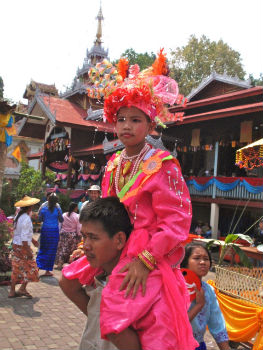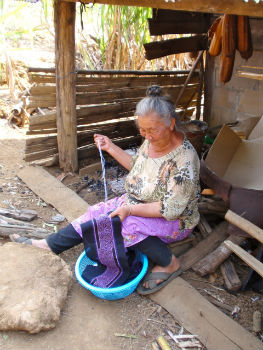タイ・スタディ・プログラム - 訪問事業の詳細
訪問事業の詳細:国連人間の安全保障基金「タイ・メーホンソーンにおける高地生活の総合的発展」事業の活動内容と現在までの進捗について

国連人間の安全保障基金は、リンク先の外務省ホームページの説明にもあるとおり、日本政府とコフィ・アナン前国連事務総長のイニシアティブにより、国連事務局に設置された国連の信託基金です。1999年の設立以来、日本からの累計拠出は約400億円、世界中で約200件もの事業を実施し、広範かつ深刻な脅威にさらされる人々をコミュニティ・レベルで支援してきました。
「タイ・メーホンソーンにおける高地生活の総合的発展」事業は同基金が支援する大型の事業の一つであり、2010年1月12日から3年間の予定で、食糧農業機関(FAO)を中心として実に8つの国連機関が合同でその実施に当たっています。具体的には、タイで最も貧しいと言われるメーホンソーン県にて、概要次のような活動を行なっています。
- 持続可能な総合的高地農業のために対象グループの能力強化を行い、所得創出作業に取り組むこと
- 技術支援、訓練及び物資の供与を通じて、環境や天然資源の管理計画実施のための支援を行うこと
- すべての人々、特に遠隔地に居住する少女・女性に、フォーマル・ノンフォーマル教育を提供し、就学率・出席率・修了率を向上させること
- 学校のカリキュラムや教材の改訂、及び教師の能力強化を図ること
- 基礎的医療機材の提供、各過程への訪問医療を含む移動式診療所を通じたアウトリーチ活動の促進、遠隔地コミュニティの診療所における一次医療の提供、十分なサービスを受けていない住民に対する保健サービスの提供のための医療従事者派遣制度の強化
- 学校再編の拡張、給食プログラム及び子どもの成長のモニタリングを、学校保健プログラムの中で実施し、子供の栄養状態を改善すること
- 農産食品開発、マーケティング、ブランディング及びエコツーリズム開発を支援し、地元の雇用・所得を創出すること ⑧ 移住者・非市民から生まれた乳幼児の出生届の提出を促進し、社会福祉・医療サービス等を享受できる権利を創出すること
これらに関して日本語での広報資料は特にありませんが、2011年10月時点で次の資料が閲覧可能です。2つ目と3つ目はPDF書類で大部かつ非常に技術的なものですが、 プロジェクトを理解する上では重要な書類と言えます。
- 2009年10月13日付外務省プレスリリースへのリンク
- 2009年10月13日に国連事務局に承認された予算案を含む最終の事業文書(Project Document)PDF 918KB
- 2011年3月11日付の2010年分事業進捗報告書(Annual Progress Report)PDF 9MB
上記のうち、最終の事業文書の「概要」(Executive Summary)と、2010年分事業進捗報告書の同じく「概要」を以下に引用します。現在のところ英語ですが、今後実行委員会にて和文への翻訳も検討します。ご参考にして頂ければ幸いです。
承認された事業文書の「事業概要」部分

Mae Hong Son province is a remote and mountainous province located in northern Thailand and shares a fairly long border with the Union of Myanmar. Although it is not densely populated, the hilly terrain and difficulty of access together with other infrastructural constraints poses an immense challenge to development efforts and attempts in improving the livelihoods of the people. Poverty incidence is high and the situation is compounded by the presence of different ethnic groups with its own distinctive language and customs including a significant migrant, local ethnic minorities, and refugee1 population, many with little if any access to social services. As a result, Mae Hong Son was ranked the lowest among all the provinces in Thailand in the Human Achievement Index in the National Human Development Report of 2007.
This Programme was therefore developed in response to the human security needs and priorities of the province as indicated in various reports and assessments over the past decade. It aims to improve the quality of life and reduce poverty among the vulnerable groups in underserved areas of Mae Hong Son through enhancing both protection and empowerment capacities. This will be carried out through a three-pronged approach of improving the skills and therefore income generating capability of the target groups (remote poor farmers, ethnic minorities, migrants and camp-based refugees); sustainable management of natural resources and increasing the opportunities in accessing social services such as health and education for the vulnerable populace.
The Programme represents a pioneering initiative of bringing together the wealth of diverse development-oriented expertise from almost a dozen UN agencies and joining hands with an equal if not more number of Thai agencies and partners in a collective effort to address the multi- faceted developmental challenges facing Mae Hong Son. It will be a test of joint commitment, resolve and solidarity, integrated, multi-disciplinary and inter-agency collaboration and the spirit of goodwill and mutual assistance. If successful in its achievements, this Programme could perhaps be a model for UN joint programming and implementation in other locations.
2010年分事業進捗報告書の「概要」部分

The United Nations (UN) Joint Programme on Integrated Highland Livelihood Development in Mae Hong Son (MHS) was officially launched during the Preamble Signing Ceremony held in the capital of MHS province on 12 January 2010. At the ceremony, all the participating UN agencies, together with UN Resident Coordinator and MHS Governor, signed the cover page of the Programme Document, formalized their commitments, and pledged to achieve human security goals in MHS through the Joint Programme.
Subsequently, at the request of the Sub‐Thematic Working Group on Livelihoods, MHS Governor designated Output‐level provincial lead agencies that act as the immediate government counterparts for the UN agencies, and proposed priority programme implementation sites, or Common Working Areas (CWAs), where all the UN agencies, the provincial counterparts, and Implementing Partners (IPs) will concentrate their efforts and activities to maximize the synergy of the programme and increase its impact on the livelihoods of target beneficiaries who are underserved and vulnerable, in particular poor farmers, migrants, ethnic minorities, and displaced persons residing near the national border.

The inception phase – from February through April 2010 – started with the arrival of Programme Manager, followed by a series of field missions by the executing UN agencies in order to finalise draft Annual Work Plan 2010‐12. As a result, the work plan was approved by the Provincial Steering Committee (PSC) at its first meeting convened in April 2010. The PSC, which consists of the UN Team, the Provincial Task Force, IPs, and the Programme Management Unit, also approved the Common Operational Guidelines and the External Communication Strategy as tools for all the stakeholders to work together and jointly produce eleven Outputs under three different programme’s Objectives to improve the quality of life and reduce poverty amongst the vulnerable groups in underserved areas of MHS.

In addition, the inception period allowed the UN Team to bring the MHS Government as an equal partner for the programme implementation, enhance collaboration with the provincial counterparts at each Output‐level, find out specific development assistance needs and gaps to fill, and finalise the selection of two CWAs – i.e. Mok Chum Pae and Tham Lod sub‐districts, or tambons (in Thai). The two CWAs were approved by the PSC together with additional CWAs for each Objective, namely, Mae Suad and Muang Pon sub‐districts to achieve Objective 1, Mae Suad and Mae Yuam sub‐districts for Objective 2, and Sao Hin and Mae La Noi sub‐districts for Objective 3.
As an immediate follow‐up to the First PSC Meeting, a Rapid Village Appraisal (RVA) was carried out in Mok Chum Pae and Tham Lod jointly by the MHS Government, UN Team, and sub‐district governments in May and June 2010. The RVA selected 8 priority villages in the CWAs, which were endorsed by the MHS Governor and the UN Team in July 2010. Similarly, in September 2010, seven villages were selected in the additional CWAs to be supported under Objective 3.

Furthermore, based on the outcome of the RVA, the MHS Government and the UN agencies involved in Objectives 1 and 2 conducted a Participatory Rural Appraisal (PRA) in the eight priority villages in August through October 2010 in order to identify constraints, opportunities, capacity building needs, and potential interventions and to help determine detailed activities to be conducted in the villages. Preliminary results of the PRA were released in November 2010, based on which the UN agencies concerned began to develop a detailed village‐level action plan in December 2010.
To complement the PRA findings and identify more detailed beneficiaries’ needs as well as potential areas for interventions specific to agro‐processing and marketing, eco‐tourism, sustainable natural resources management, and renewable energy, Output 1.2, Output 1.3 and Output 2.1 groups started to prepare baseline studies on their respective thematic areas. An Objective 3‐wide baseline survey was also planned with the Provincial Office as the coordination body and in close collaboration with the provincial lead agencies concerned with Objective 3 for the coordination, implementation, management, and monitoring of the survey.


